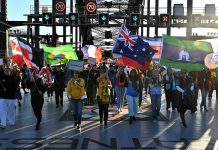Diverging from the consensus of 2-3 per cent GDP growth, the economy is expected to have a K-shaped recovery — disparity in the rates of expansion in different sectors — in 2021.
It is likely to grow by over 4pc on the strength of industry and construction, as agriculture and services trail behind, against negative growth of 0.4pc in 2020 defined by Covid-19 that turned the whole world topsy-turvy.
The benefits of growth may not disperse equitably. The chances are that people on both extremes of the social spectrum in urban Pakistan will gain but the situation may continue to be rough for 80pc of the population in the middle. If not addressed, the public discontent can spill into streets.
Keeping with the trend, agriculture may expand at a rate tad higher than the five-year average of 1.94pc while manufacturing provides the impetus by posting a steep rise over the five-year average growth rate of 2.6pc. But the services sector may at best achieve the five-year average growth of 4.6pc. The fortunes of the services sector are closely tied to Pakistan’s success on the Covid-19 front.
Both domestic and external debt might increase. The rise in deficit financing and a hike in fuel and utility prices may keep inflation in double digits. The trade deficit may shrink and remittances increase but external liabilities will still pile pressure on the exchange rate to further erode the rupee’s value. The future of the China-Pakistan Economic Corridor (CPEC) will depend on the government’s success in neutralising the public perception of serving interests other than those of the people.
In this Special Report, the Dawn B&F team takes a bold plunge to predict the future based on whatever little data and analyses were available
What’s been done on the economic front, after the lockdown last year virtually paralysed the economy, was necessary but not sufficient. The government needs to do more. It needs to ensure that the private sector share their profits more equitably, pay taxes judiciously and create jobs.
Agriculture is crucial for food security and providing raw material for industries. Better coordination between all tiers of the government can produce better outcomes. The provision of basic physical and social services at affordable rates is the government’s responsibility for which it will be held accountable.
History tells us that stressful times are fertile for market manipulation. Sugar and wheat crises have highlighted the issue. The PTI government will need to be vigilant to not let anyone play the market.
The sustainability of growth will depend on multiple factors but complying with health-related global protocols for the cross-border movement of people and consignments will be crucial. Any misstep can compromise export prospects besides health and safety of the nation.
The scale of death and disruption caused by the pandemic in 2020 was unfathomable. In a matter of months, the world lost gains of decades of hard work and slipped helplessly into a recession. Pakistan also had its share of suffering. It is a riddle as to what saved us from the horror that visited others but the role of the federal and provincial governments in containing the spread of the virus is commendable. The ordeal is far from over. The politicisation of Covid-19 can invite a catastrophe we dodged earlier.
The loss of life and livelihood is tragic. Had the government not responded the way it did, it could have been much worse. The relief and stimulus package supported by emergency funding from the International Monetary Fund (IMF), World Bank, Asian Development Bank (ADB), China and Saudi Arabia lifted the spirit of battered people and businesses. The culture of philanthropy and the networks of community organisations also helped us wade through the rough patch.
The convergence of pent-up local demand, import orders diverted from competing nations, monetary and fiscal stimulus packages and massive concessions for the construction sector energised the growth drivers. The spike in investors’ confidence drove the KSE-100 index to a three-year high and the expansion in textile mills working on full capacity looks imminent. Lured by the success of existing companies, multiple new players have entered the auto sector. Cement, steel and related industries are gearing up to match the rising demand. The Pakistan Bureau of Statistics (PBS) reported 6.5pc growth in large-scale manufacturing (LSM).
The growth wave in the making, however, is not expected to lift all boats. The absence of the government’s attention/action on the flawed elitist economic framework may intensify income and regional disparities. It could aggravate social polarisation propelling into another cycle of disruptive events.
The stimulus package has elated barons, bankers and brokers but Pakistan’s teeming millions — workers, peasants, professionals and service-providers — resent the government’s apathy towards their sufferings. They aspire for jobs and better salaries to afford decent and dignified lives.
All the talk about financial discipline, Financial Action Task Force (FATF), IMF, corruption, curtailing expenses, revenue collection, suppressed imports, rising exports, market-driven exchange rate regime and tax exemptions fail to impress people. For common folks, the litmus test for the success of a government is the state of their own households. If their families end up more distressed, then the fancy talk of success only frustrates people, diminishing the trust in the government.
Argumentative Pakistanis are not inclined to accept hardships as fate. Many can see through the market collusions. They question shortages and price volatility in wheat, sugar, LNG, petrol and electricity. Direct cash transfers under the Ehsaas programme provide a temporary relief to the poorest of the poor but it can’t substitute for gainful employment.
The revival of the IMF’s Extended Fund Facility of $6bn, suspended in February 2020, will again force the government to prioritise fiscal discipline over growth-inducing measures.
People braved a very rough 2020. They expect relief. Direct petty cash transfers can’t sustain them. They need jobs, better salaries and affordable efficient service delivery. The government spent what it had to for reenergising the private sector but it could have used the stimulus for job creation and revenue generation. Why did the government not do that? Your guess is as good as mine.
The unceremonious exit of the Musharraf/Shaukat Aziz regime that delivered high growth or people turning the tables in elections on the BJP government clearly demonstrates that growth on its own is not sufficient to generate political capital.








